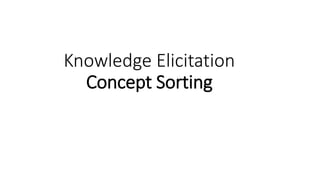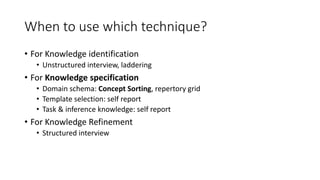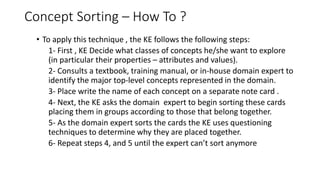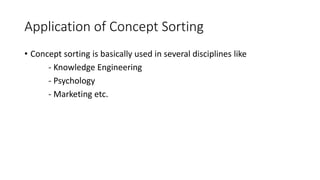Knowledge Elicitation Techiniques Concept Sorting
- 2. Knowledge Elicitation (Introduction) ŌĆó Knowledge Elicitation is the process of acquiring knowledge about a specific domain. ŌĆó It is one of the most important and a crucial task of the development of an expert system since it directly has an impact on the overall quality of the system. ŌĆó Knowledge elicitation is also often viewed as the bottleneck in the development of expert systems or knowledge based systems as it is difficult and time consuming activity. ŌĆó Among various known Knowledge Elicitation techniques available choice to be used depends on the nature of the situation within which the knowledge is elicited, the domain knowledge and availability of experts.
- 3. Knowledge Elicitation (Introduction) ContŌĆ” ŌĆó Knowledge Elicitation process gets tricky as the vast amount of information is often kept inside the heads of domain experts. ŌĆó This makes the entire process complicated as the domain experts may not be willing to disclose the information, due to worries of being sidelined or becoming less important or getting redundant. ŌĆó There are various techniques used in the Knowledge Elicitation process : ŌĆó Interview ŌĆó Protocol Analysis ŌĆó Laddering ŌĆó Concept Sorting (Will be discussing) ŌĆó Repertory Grid ŌĆó Structural Assessment
- 4. When to use which technique? ŌĆó For Knowledge identification ŌĆó Unstructured interview, laddering ŌĆó For Knowledge specification ŌĆó Domain schema: Concept Sorting, repertory grid ŌĆó Template selection: self report ŌĆó Task & inference knowledge: self report ŌĆó For Knowledge Refinement ŌĆó Structured interview
- 5. What is Concept Sorting ? ŌĆó Concept sorting is a psychological technique that is useful in tapping organization knowledge. ŌĆó It a way of finding out how an expert compares, orders concepts and relates among a set of concepts. ŌĆó Used to capture conceptual knowledge and tacit knowledge. ŌĆó Can also sort objects or pictures instead of cards ŌĆó It works best on small group. ŌĆó Simple to apply ŌĆó Its is also Called Card Sorting. ŌĆó Simplest form is Concept Sorting ŌĆó Collection of concepts (or other knowledge objects) are written on separate cards ŌĆó Cards sorted into piles by an expert in to piles - each card in a pile must have something in common ŌĆó Each time the cards are sorted it will be based on an attribute and each pile will represent a value
- 6. Concept Sorting ŌĆō How To ? ŌĆó To apply this technique , the KE follows the following steps: 1- First , KE Decide what classes of concepts he/she want to explore (in particular their properties ŌĆō attributes and values). 2- Consults a textbook, training manual, or in-house domain expert to identify the major top-level concepts represented in the domain. 3- Place write the name of each concept on a separate note card . 4- Next, the KE asks the domain expert to begin sorting these cards placing them in groups according to those that belong together. 5- As the domain expert sorts the cards the KE uses questioning techniques to determine why they are placed together. 6- Repeat steps 4, and 5 until the expert canŌĆÖt sort anymore
- 7. Example 1: Classification based of Habitat Star Fish Bear Cat Shark Deer Seahorse Crab Crocodile Frog Elephant Dolphin
- 8. Example 1: Classification based of Habitat ContŌĆ” Dolphin Aquatic Animals ns Terrestrial Animal Star Fish Bear Cat Shark Elephant Deer Seahorse Crab Crocodile Frog Amphibia
- 9. Card Habitat Size Eating Habit Vertebrate / Invertebrate Mammals/ Non Mammals Elephant 1 3 1 1 1 Cat 1 1 3 1 1 Deer 1 2 1 1 1 Bear 1 3 3 1 1 Crab 2 1 2 2 2 Crocodile 2 3 2 1 2 Frog 2 1 2 1 2 Dolphin 3 2 3 2 1 Starfish 3 1 3 2 2 Sea Horse 3 1 3 1 2 Shark 3 3 2 1 2 1-Teresstrial 1-Small 1-Herbivorous 1-Vertebrate 1-Mammals 2- Amphibia 2-Medium 2-Carnivorous 2-Invertebrate 2-Non-mammal 3-Aquatic 3-Large 3-Omnivorous
- 10. Example 2 ŌĆó The Number of 15 models of cars may be grouped into two categories named ŌĆ£Foreign" and ŌĆ£Domestic ŌĆó Then re-sorted into three categories; ŌĆ£Sedan" , ŌĆ£Hatchback", and ŌĆ£Sports"; ŌĆó Then re-sorted into four categories; " Expensive Domestic", " Less Expensive Domestic", " Expensive Foreign", ŌĆ£Less Expensive ForeignŌĆ£. ŌĆó A hierarchy tree may be created expressing the group categories as levels within the hierarchy.
- 11. Based on Cost Based on Design and Performance Based on Design and Performance Based on Cost Example 2 ContŌĆ” Domestic Cars Foreign Less Expensive Expensive SedanHatchback Sports Less Expensive ExpensiveSedanHatchback Sports
- 12. Application of Concept Sorting ŌĆó Concept sorting is basically used in several disciplines like - Knowledge Engineering - Psychology - Marketing etc.
- 13. Pros and Cons ŌĆó Pros ŌĆó Fast to apply and easy to analyze ŌĆó Often instructive to the expert in a sense that it may lead expert to see structure that he himself has not consciously articulated before ŌĆó Time saving by not having to transcribe and analyze lengthy verbal reports ŌĆó Can be used for images and objects as well
- 14. Pros and Cons ContŌĆ” ŌĆó Cons ŌĆó Experts can often confound dimensions by not consistently applying the same semantic distinctions throughout an elicitation session ŌĆó May face problem in categorization of elements in meaningful way
- 15. Conclusion ŌĆó Card Sorting techniques provide a means of achieving a more focused or systematic understanding of the classifications and relationships in the expert's domain.















